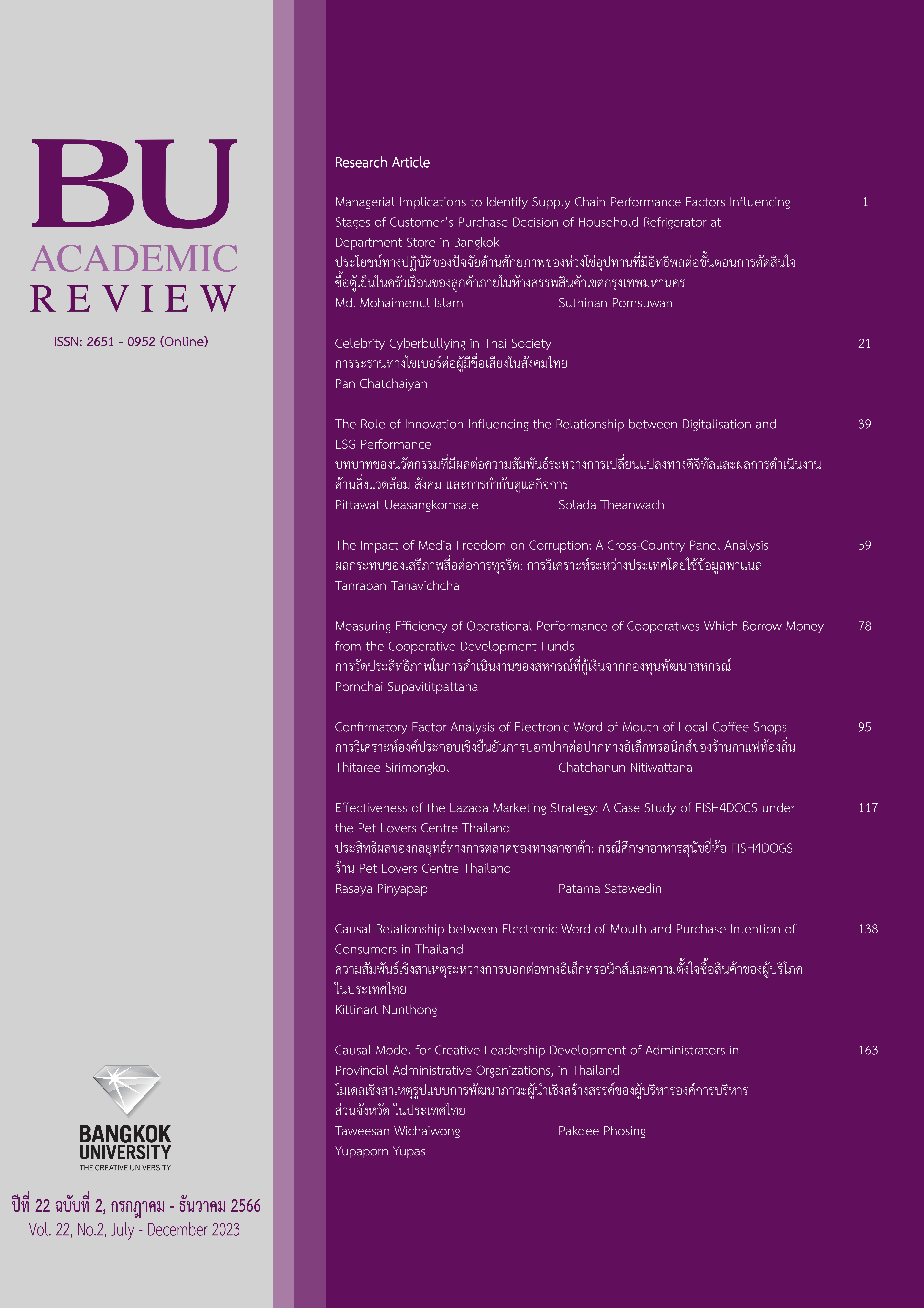ความสัมพันธ์เชิงสาเหตุระหว่างการบอกต่อทางอิเล็กทรอนิกส์และ ความตั้งใจซื้อสินค้าของผู้บริโภคในประเทศไทย
Main Article Content
บทคัดย่อ
การวิจัยครั้งนี้มีวัตถุประสงค์เพื่อ 1) ศึกษาความสัมพันธ์เชิงสาเหตุของการบอกต่อทางอิเล็กทรอนิกส์ของผู้บริโภคในประเทศไทย 2) วิเคราะห์องค์ประกอบเชิงยืนยันบุพปัจจัยการบอกต่อทางอิเล็กทรอนิกส์ที่ส่งผลต่อความตั้งใจซื้อสินค้าของผู้บริโภคในประเทศไทย และ 3) ศึกษาปัจจัยของการบอกต่อทางอิเล็กทรอนิสก์ที่ส่งผลต่อความตั้งใจซื้อสินค้าผู้บริโภคในประเทศไทย งานวิจัยนี้เป็นการวิจัยแบบผสานวิธี การวิเคราะห์ข้อมูลเชิงคุณภาพใช้การวิเคราะห์เนื้อหา ผลการวิเคราะห์ พบว่า สอดคล้องกับการทบทวนวรรณกรรมและงานวิจัยที่เกี่ยวข้องด้านการบอกต่อทางอิเล็กทรอนิกส์ ส่วนการวิจัยเชิงปริมาณ ผลการวิเคราะห์สมการโครงสร้าง พบว่า โมเดลมีความสอดคล้องกับข้อมูลเชิงประจักษ์ จำนวนข้อคิดเห็นส่งทางตรงเชิงบวกต่อความตั้งใจซื้อ จำนวนข้อคิดเห็นและคุณภาพข้อคิดเห็นส่งผลทางอ้อมเชิงบวกต่อความตั้งใจซื้อโดยมีประโยชน์ของข้อมูลและการบอกต่อทางอิเล็กทรอนิกส์เป็นตัวแปรส่งผ่าน ประเภทข้อคิดเห็น ความน่าเชื่อถือของข้อมูล ส่งผลต่อความตั้งใจซื้อโดยมีความน่าเชื่อถือของการบอกต่อทางอิเล็กทรอนิกส์และการบอกต่อทางอิเล็กทรอนิกส์เป็นตัวแปรส่งผ่าน และสามารถพยากรณ์ความตั้งใจซื้อได้ร้อยละ 74.00 ที่ระดับนัยสำคัญทางสถิติ .05
Article Details

อนุญาตภายใต้เงื่อนไข Creative Commons Attribution-NonCommercial-NoDerivatives 4.0 International License.
บทความที่นำมาสมัครลงตีพิมพ์ในวารสารต้องไม่เคยได้รับการตีพิมพ์เผยแพร่มาก่อน และไม่ส่งต้นฉบับบทความซ้ำซ้อนกับวารสารอื่น รวมทั้งผู้เขียนบทความต้องไม่ละเมิดหรือคัดลอกผลงานของผู้อื่น
เอกสารอ้างอิง
Abedi, E., Ghorbanzadeh, D., & Rahehagh, A. (2020). Influence of eWOM information on consumers’
behavioral intentions in mobile social networks: Evidence of Iran. Journal of Advances in Management Research, 17(1), 84-109.
Abramyk, H. (2020). Top 10 review websites to get more customer reviews on (2020). Retrieved June 1, 2023, from https://www.vendasta.com/blog/top-10-customer-review-websites/
American Psychological Association. (2021). APA dictionary of psychology. Retrieved June 2, 2023, from https://dictionary.apa.org/argument-quality
Anastasiei, B., & Dospinescu, N. (2019). Electronic word-of-mouth for online retailers: Predictors of
volume and valence. Sustainability, 11(3), 1-19.
Ajzen, I. (1991). The theory of planned behavior. Organizational Behavior and Human Decision
Processes, 50(2), 179-211.
Awad, N. F., & Ragowsky, A. (2008). Establishing trust in electronic commerce through online word of
mouth: An examination across genders. Journal of Management Information Systems, 24(4), 101–121.
Beneke, J., de Sousa, S., Mbuyu, M., & Wickham, B. (2016). The effect of negative online customer
reviews on brand equity and purchase intention of consumer electronics in South Africa. The International Review of Retail, Distribution and Consumer Research, 26(2), 1-31.
Bhattacherjee, A., & Sanford, C. (2006). Influence processes for information technology acceptance:
An elaboration likelihood model. MIS Quarterly, 30(4), 805-825.
Bilal, M., Jianqiu, Z., Dukhaykh, S., Fan, M., & Trunk, A. (2021). Understanding the effects of eWOM antecedents on online purchase intention in China. Information, 12(5), 192.
Blazevic, V., Hammedi, W., Garnefeld, I., Rust, R. T., Keiningham, T., Andreassen, T. W., Donthu, N., & Carl, W. (2013). Beyond traditional word‐of‐mouth: An expanded model of customer‐driven influence. Journal of Service Management, 24(3), 294-313.
Bobkowski, P. S. (2015). Sharing the news: Effects of informational utility and opinion leadership on
online news sharing. Journalism & Mass Communication Quarterly, 92(2), 320-345.
Borghi, M., & Mariani, M. (2021). Service robots in online reviews: An empirical study of online robotic
discourse. Annals of Tourism Research, 87, 1-9.
Cheung, C. M., Lee, M. K., & Rabjohn, N. (2008). The impact of electronic word‐of‐mouth: The adoption of
online opinions in online customer communities. Internet Research, 18(3), 229-247.
Cheung, C. M. Y., Sia, C. L., & Kuan, K. K. Y. (2012). Is this review believable? A study of factors
affecting the credibility of online consumer reviews from an ELM perspective. Journal of the Association for Information Systems, 13(8), 618-635.
Cheung, C. M. K., & Thadani, D. R. (2012). The impact of electronic word-of-mouth communication:
A literature analysis and integrative model. Decision Support System, 54(1), 461-470.
Cyr, D., Head, M., Lim, E., & Stibe, A. (2018). Using the elaboration likelihood model to examine
online persuasion through website design. Information & Management, 55(7), 807-821.
Erkan, I., & Evans, C. (2016). The influence of eWOM in social media on consumers’ purchase
intentions: An extended approach to information adoption. Computers in Human Behavior, 61, 47-55.
Fang, Y. H. (2014). Beyond the credibility of electronic word of mouth: Exploring eWOM adoption
on social networking sites from affective and curiosity perspectives. International Journal of Electronic Commerce, 18(3), 67-102.
Filieri, R. (2016). What makes an online consumer review trustworthy? Annals of Tourism Research,
, 46-64.
Ghosh, A., Varshney, S., & Venugopal, P. (2014). Social media WOM: Definition, consequences and
inter-relationships. Management and Labour Studies, 39(3), 293-308.
Hajli, N. (2020). The impact of positive valence and negative valence on social commerce purchase intention. Information Technology & People, 33(2), 774-791.
Hameedunissa, M., Nisha, A. R., & Sundary, T. (2021). Buyer behavioural impact of electronic word of mouth among youngsters towards smart watches in chennai city. Turkish Journal of Computer and Mathematics Education (TURCOMAT), 12(10), 5723-5726.
Hennig-Thurau, T., Gwinner, K. P., Walsh, G., & Gremler, D. D. (2003). Electronic word-of- mouth:
Motives for and consequences of reading customer articulations on the Internet.
International Journal of Electronic Commerce, 4(8), 51-74.
Heryana, D. K., & Yasa, N. N. K. (2020). Effect of electronic word of mouth on repurchase intention
mediated by brand attitude. International Research Journal of Management, IT & Social Sciences, 7(2), 9-20.
Hong, S., & Pittman, M. (2020). eWOM anatomy of online product reviews: Interaction effects of review number, valence, and star ratings on perceived credibility. International Journal of
Advertising, 39(7), 892-920.
Hsieh, J. K., & Li, Y. J. (2020). Will you ever trust the review website again? The importance of source
credibility. International Journal of Electronic Commerce, 24(2), 255-275.
Hui, T. X. (2017). The effect of source credibility on consumers’ purchase intention in Malaysia
online community. Journal of Arts & Social Sciences, 1(1), 12– 20.


